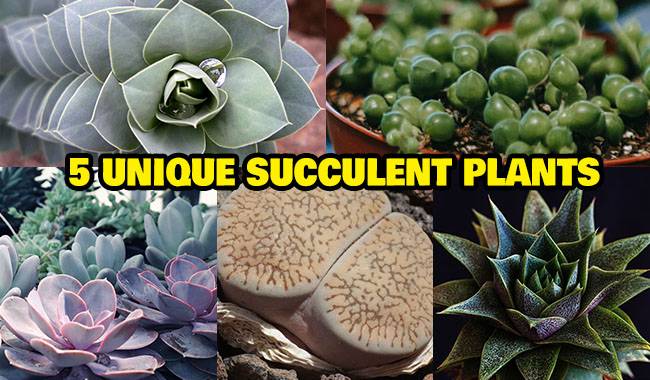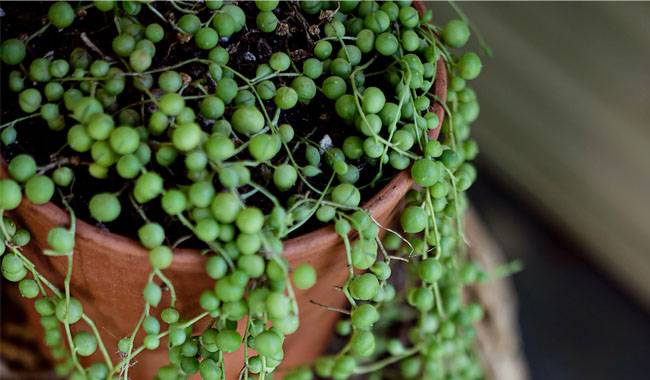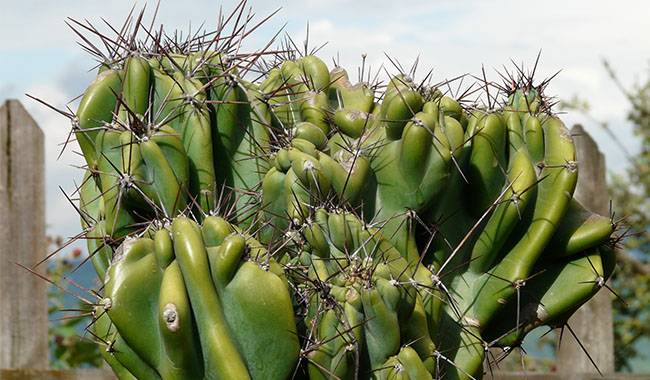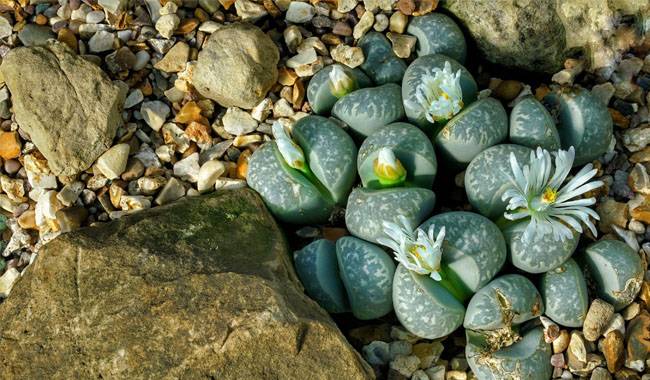
Succulents Lithops, commonly known as “living stones” or “pebble plants,” are members of the Aizoaceae family. The name is derived from the ancient Greek words λίθος (líthos), meaning “stone,” and ὄψ (óps), meaning “face,” referring to the stone-like appearance of the plant. They avoid being eaten by blending in with the surrounding rocks. Lithops is formed from the ancient Greek word “-ops,” meaning that even a plant is called Lithops. in nature, it prefers to grow on limestone, granite, and rocky dehydrated soil. This exotic plant has a very unusual appearance: it has only a few huge leaves no more than 50 mm high and wide.
The leaves of lithops plant look very much like small pebbles. During the flowering period, from late August to mid-October, a flower stalk forms between these leaves, after which the flower buds open. When the shrub flowers, a seed cone is formed, which opens when it rains. This perennial plant is native to the southern regions of South Africa, more specifically, the deserts of Botswana and Namibia.
The petals of the flowers are similar in appearance to those of chamomile. The fragrant flowers are mostly yellow or white. The shrub is an extremely slow-growing plant. It will reach about 50 mm in ten years, but its maximum lifespan is 15 years. Lithops is easy to care for and easy to grow. It is perfectly suitable for all flower growers, even beginners.
A BRIEF DESCRIPTION OF THE CULTIVATION OF LITHOPS
- Temperature. In the warm season, this plant is not even afraid of intense heat. In winter, the temperature in the room should not fall below 59-68 °F (15-20 °C).
- Air humidity. Feel best in a room with low air humidity.
- Lighting. South-facing windows need lots of bright sunlight.
- Watering. Water succulents infrequently in summer, i.e., every 4-6 weeks. In the winter, the substrate in the pot is not moistened at all.
- Soil. Ready-made soil for cactus pots can be used. It can be a mixture of sand and clay with some garden soil.
- Fertilizer. Fertilize only in summer and use cactus fertilizer.
- Transplanting. Use only when necessary if the bush grows too large. Lithops can usually be replanted every few years.
- Propagation. By seed. Less popular method – dividing leaf plates.
- Care. Succulents react negatively to rain, providing them with protection from excessive moisture. Therefore, when the bush blooms, its leaf plates shrivel. However, after a very short time, new leaves will form. This process is known as “molting.” Several clumps of Lithops should be planted in the same container to increase Lithops’ effect and speed up its development.
HOME CARE OF LITHOPS
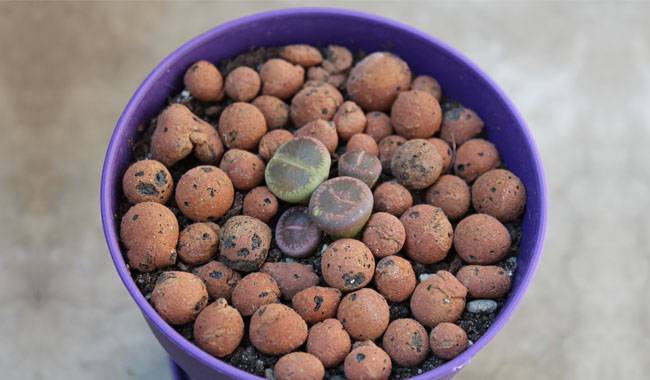
Temperature
During the warm season, Lithops is not afraid of heat or drought. It can stay in high temperatures for a long time without any problems. Therefore, you can not pay too much attention to the temperature in the room in summer – it can vary from 73 °F (23°C) and up. In winter, when the development of the plant slows down, the flowers are moved to a cooler room where the air temperature should be between 53-68 °F (12-20 °C).
Interestingly, the plant responds well to temperature changes. This is why experienced flower growers recommend moving pots with succulents from the windowsill to the floor at night, where the air temperature is slightly cooler.
Spraying
It is recommended to moisten indoor Lithops with a sprayer only under the following conditions
- During molting, only if the shrubs are observed to be physically shrunken.
- Shortly before the start of the dormant period, when a new young body is forming.
- Spray in the morning during the first weeks of August, trying to imitate dew.
Remember that you must always use a fine mist sprayer when wetting your shrubs. Make sure there is enough water so that Lithops can dry quickly (in less than 1 hour).
Brightness
This succulent has a very high level of light. Therefore, even a small lack of sunlight can cause stunted growth. A balcony, open sunny window, or patio is best for Lithops, although the shrub only needs to be temporarily shaded from the midday sun.
In winter, the shrub can be given additional light. A plant light should be used for this purpose at a distance of 100 mm from the succulent plant. In the case of newly emerged seedlings, this distance should be approximately 50 mm.
Lithops are usually slightly shaded in the store. Therefore, once you buy it, it will need to get used to direct sunlight gradually. If you immediately put it on a sunny windowsill, it will cause burns on the surface of the leaves.
Watering
An important rule when wetting and watering shrubs is to make sure there is no standing water at the base of the leaves. Try to avoid getting any liquid on the plant and use enough water so that it can be absorbed quickly by the substrate rather than staying on the surface for hours.
When watering, try to ensure that the water only reaches the surface of the substrate between the bushes. Failure to do so will result in rot or burn marks (only when the bush is exposed to direct sunlight). Water succulents with only a small amount of water, even if the leaves are wrinkled, and soak the substrate to a depth of about 10 mm.
Experienced growers recommend using a small syringe for watering. This will moisten the substrate in a very gentle way without damaging the succulents.
Choosing a pot
A suitable pot for Lithops should be where the roots do not want to be too crowded or too large. A wide and shallow pot with a few shrubs planted inside is best. This will speed up the growth of Lithops.
Potting soil
You can use commercially available generic cactus substrates for growing and transplanting home Lithops. You can also use other pre-made potting soil as long as it does not contain peat.
You can make your own substrate by combining gravel aggregate (or sand), brick chips, leaf soil, charcoal, and clay in a ratio of 4:2:2:1:1. It is recommended to sterilize the substrate before sowing. Please place it in a heated oven and leave it on the stove for 30 minutes. Make sure to place a layer of expanded clay pebbles on the bottom of the pot. If desired, you can put a 10 mm thick layer of fine pebbles on top after planting.
Fertilization
Lithops do not need to be fertilized often, especially if it is transplanted every year. Fertilizer should only be applied to the substrate if the succulent has not been transplanted for several years and the potting soil has started to run out. Special cactus fertilizer is the best fertilizer to use. Half the manufacturer’s recommended dose (see package) is sufficient for Lithops.
Transplanting after purchase
Lithops purchased at specialty retailers need to be transplanted as soon as possible, and the substrate completely changed. In fact, Lithops sold are usually grown in a moist peat soil mixture. Since this substrate does not have high drainage properties, the plants may suffer and even die.
Once you have removed the shrub from the substrate, use a stiff brush or toothpick to remove the old potting soil from the roots carefully. If the potting soil is wet, allow the roots to dry out sufficiently before planting. Place the shrub in a new pot with a suitable substrate, ensuring that its roots are straight when planted. Fill the pot with the substrate without compacting it, making sure that the neck of the shrub is not covered. To prevent it from toppling over, use a small stone to support it. Remember that you should not water the planted shrub for a few days.
Transplanting Lithops
Report this succulent only if its root system overgrows and becomes overcrowded in the container. During repotting, a portion of the root system can be cut off if desired. However, if the roots are not traumatized and are completely healthy, it is best not to cut them at all.
It is recommended to plant several shrubs in the same pot, leaving at least 10-15 mm of space between the shrubs. All gaps should be filled with potting soil, and the soil should not be compacted. However, make sure that no gaps are left. Transplanted succulents should not be watered for a few days. This shrub will bloom in the next cycle after about 1 year.
Pruning
There is no need for shaping or sanitary pruning of room heather. The shrub can get rid of leaves that have started to fade on their own, but removing them with your own hands is highly undesirable.
Lithops overwintering
During winter, Lithops may appear to be dormant, but this is not the case. A very important process is taking place within the plant, and new leaves are being produced. Their relatively rapid development and growth are made possible by the resources available to the older, dead leaves.
In the wild, the end of the “molting” process occurs during the rainy season. Rainfall causes the withered pair of leaves to split and new, tender leaves to appear inside. For Lithops grown as houseplants, you can see how the young leaves thrive in a short period of time while the older leaves completely wither and become more skin-like.
No special care is needed for the plant during the molt. However, the substrate in the pots should not get wet until the new leaves are fully developed.
Dormant period
The true dormancy period of this succulent is in spring and summer. It begins immediately after the “slow” growth period that can be observed in winter.
During this time, the shrub grows very slowly and stores energy for the formation of flowers in autumn. Therefore, there is no need to feed a dormant shrub. Any watering should also be avoided, as this can lead to the decay of the flowers, which can kill them. However, if the young leaves begin to wrinkle, water very sparingly, and the plant will soon return to normal.

Lithops flowering period
To fully understand the flowering characteristics of succulents such as Lithops, it is first necessary to understand their main growth and developmental stages.
- In early June, Lithops shows a pause in growth and development and begins its dormant period. During this time, no fertilizer should be applied to the soil, and wetting of the soil is prohibited.
- Watering of succulents resumes in mid-August. This will allow the shrub to wake up and continue to grow. At this time, you will notice that the cut between the two leaves has become larger, and a flowering stem begins to form. In the fall, you can enjoy the flowers of this unusual plant.
- In winter, the plant will have the third stage of its cycle, which is called forcing. During this time, the shrub grows more slowly, and the leaves change, or “molt.”
- In early March, the old leaves turn into translucent skin. It will then die completely, and new leaves can be seen underneath.
The life cycle of this plant is unusual. However, this cycle may vary slightly, depending on the species and cultivar. For example, in the mid-latitudes, this shrub may not bloom in autumn but mid-summer. However, this is only possible if the shrub receives good additional light in winter and its leaves renew earlier than they should.
The flowering period of Lithops is about 2 weeks. The flowering period is 3-5 years, and the flowers are daisy-shaped, yellow, or white. The flower buds open at midday and close in the evening. When the shrub has finished flowering, the old leaf lamellae separate further, and a new pair of relatively vigorous leaflets appear between them. A seedling will form in the place of the flower and will take several months to mature.
GROWING LITHOPS FROM SEED
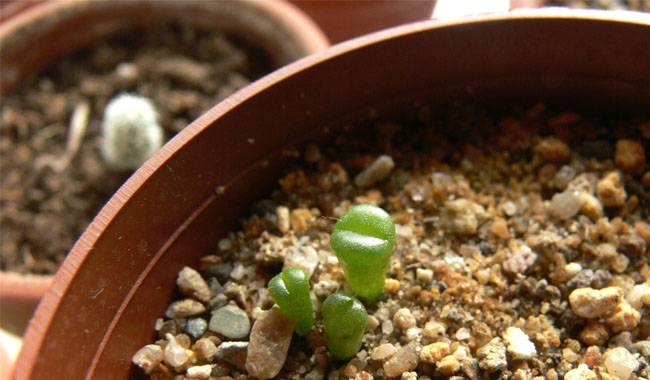
Lithops are most often propagated indoors from seed. The seeds are sown in early spring. Soak the seeds for a while and then distribute them evenly on moist soil, which must be sterilized beforehand. The seeds must not be submerged or covered with the substrate. Instead, cover the seeds with glass or cling film and keep them warm at 77-86 °F (25-30 °C). Do not forget to dry them daily.
The first seedlings should appear after 1-4 weeks. Once the seedlings have grown to 10 mm in size, cover the surface of the substrate in the container with a thin layer of clay pebbles. Once the seedlings have survived the first winter and have grown a little, they should be taken apart and put into permanent pots.
ABOUT LITHOPS THE COMMON PROBLEM
When growing Lithops in home conditions, some problems may arise, as follows.
- Light-colored leaves. This happens because the process of changing the wilted leaves is disrupted.
- Wrinkled leaf plates. This indicates a severe lack of moisture, which can be observed during the dormant period. This can also be a problem caused by spider mites.
- Root rot. The plant has been in a moist potting soil mixture containing peat for a long time.
- The leaf layer swells and tears. Excessive frequent or heavy watering.
- Brown spots appear on the leaves. It happens if irrigation rules are not followed.
- The leaf pattern becomes discolored. This is because the plant suffers from too little light.
- Lack of flowering. There are too many nutrients in the substrate, or the rules for maintaining succulents during dormancy are broken.
- Pest infestation. Rootworms(Leaf beetles), spider mites, and fungal mites can infest the shrub.
More Related Information About Planting & Growing Indoor Plants




